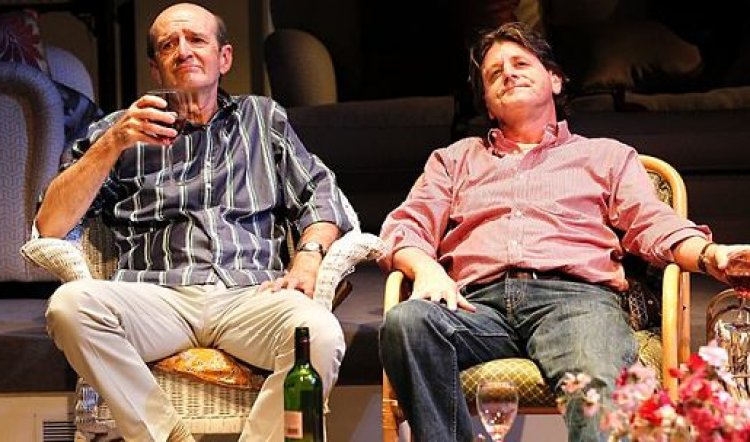
DON PARTIES ON
DON PARTIES ON, MTC and Rachel Healy Productions at the Sydney Theatre, February 18-March 8 2011.
IN THE PROGRAM notes for his sequel to Don’s Party, the author of the potted biography of David Williamson is not credited, but he or she inadvertently provides one of the best one-liners in an evening of one-liners: “He celebrates forty years as his tribe’s myth-maker: part sceptic, part psychoanalyst and part Sharman ”
Quite why the curly-haired, extra-tall Williamson should be equated with the bone-domed, average height director is one of the many mysteries of Don Parties On. Another is the persistent repetition of the idea that there is a tribe in Australia with what amounts to a cargo cult attitude towards the playwright.
This “tribe” is, in reality, the majority of the population that requires nothing more nor less than a nice night’s entertainment with as few challenges or surprises as possible. Whether that entertainment is presented in a stadium, on an oval or in a theatre is immaterial. It’s an audience that cares little for anything beyond the evening itself and is happy to leave the venue without a backward thought. It’s why relying on this audience for comfort and affirmation is dangerous. During the opening week in Melbourne Williamson wrote in The Spectator that the first preview audience loved Don Parties On but that he knew “the critical vultures are already circling and there’s nothing some of them hate more than to see an audience enjoying themselves.”
This may be true of some critics although I doubt it, but Williamson misses the point: popularity with the majority does not guarantee or even imply quality and excellence. If that were so we’d all be eating at McDonald’s every day, loving it and not hoping for, aspiring to or demanding anything better.
First of all, on the Sydney opening night of Don Parties On much of the audience had a good time, laughed a lot and got what they came for. What they did not come for, therefore, was a well-crafted, well-written social comedy of bad manners and credible characters. What they clearly didn’t care about was the play’s flimsy structure that, if it had been a building, would have been condemned shortly before falling over.
Neither did they care about dialogue and exposition so clumsy it could make your eyes water – “Well Don, that was our son Fred on the phone,” “Really Kath? Did he want to tell us something dreadful has happened to his wife Dolores?” “Yes Don and I don’t think we should tell our granddaughter Belle who’s watching DVDs in her bedroom.” “Okay, let’s get the drinks ready for our friends Cooley and Helen who we haven’t seen since our last party 40 years ago.” You get the drift. Williamson is more than capable of style, agility and wit in crafting a script, so why he settled for this clunky nonsense is yet another mystery. A Melbourne critic accused him of laziness – and he’s railed against that with contrasting energy – but it’s the description that comes instantly to mind.
A further oddity is that someone thought – against overwhelming evidence to the contrary – that a sequel to the seminal 1971 Don’s Party would be a good idea. Sequels are most often far less than the original – as is the case here. Don’s original party was set in Don and Kath’s suburban home on the night of the 1969 federal election. The friends are Laborites but that was beside the point: their personal-political relationships were the real meat of the play. Forty years on and the 2010 election brings the survivors together once more; and again it’s the people rather than the politics that are the play’s raison d’etre.
Tragically, however, despite valiant performances from a gutsy cast, the people they are required to portray are little more than ciphers. The only three-dimensional aspect of the production is the splendid stage design by Dale Ferguson (lighting by Matt Scott). It distills signifiers of middle class life into one beautifully rendered set of sumptuous kitchen, carport beyond featuring luxe transport; comfortable living room with plasma TV, iPod+dock and a tasteful water feature in a courtyard beyond the picture windows. Don and Kath epitomise baby boomer living and as played by a nicely subdued Garry McDonald and brittle, sad Tracy Mann, they’re as good as their material permits.
Frankie J Holden as the emphysemic pantsman-turned-Liberal, Cooley, doesn’t bother with permission: he gives it his all and is a scene-stealing spark of life. As Don’s best friend Mal Robert Grubb attempts the same approach but is less successful, probably because his role is colourless and glum in the extreme. As Helen, Cooley’s long-suffering yet amusingly snarky wife, Diane Craig looks too young and gorgeous butwhat the hell. Georgia Flood does her best as granddaughter Belle, but her role is risible: she pops on and off stage to deliver ever more incredible moments of alleged Gen Y-ness and mercifully spends most of her time in her bedroom with the DVDs.

As Mal’s long divorced wife and font of personal secrets and tragedies, Sue Jones is a gritty Jenny. Potentially this character is the one to build another play around: Labor politician who’s made it almost to the top and is now unwillingly on the way down. Here, though, she spends most of her time snarling bitterly and getting drunk: gifts to any actress and grabbed with both hands by this one.
And that leaves a further mystery in the godawfully written role of Don and Kath’s now 42-going-on-14-year-old son Richard. His wife is in hospital after attempting suicide because he’s left her for a younger woman. This defies credibility because any sane woman would be sending flowers and heartfelt expressions of thanks to the girlfriend for taking him off her hands. Arrested development comes to mind in describing a whining ninny who’s nevertheless supposed to be highly successful and attractive.
Interestingly, an obviously big laugh moment when his mother orders him to his old room to lie down – as if he were still a naughty 9-year-old – fell flat as a pancake on opening night. Not even the casting of the brilliant Darren Gilshenan can save this gruesome character. The only time this fine actor looks remotely comfortable is when he’s obediently shuffling off to his room (and blessed relief from being onstage).
The final straw is Richard’s new love, the unlikely femme fatale Roberta whose psychological profile may have been devised from Googling narcissistic symptoms. Nikki Shiels doesn’t stand a chance against this kind of script opposition and the less said the better.
Robyn Nevin is lucky in that she plays the director and is therefore not required to actually appear on the stage. She’s good at crisp, pacy comedy – as an actor and director – and she does all of this and more for this one, but it’s not enough and not her fault (unless it was her idea in the first place).
Times have changed since that far off election night and the election of 2010 was as different from it as Creedence Clearwater Revival is from Mary Hopkin. Both are used to bookend this production and each supplies one of the few moments of poignancy in the two and a half hours, including interval, of the production. Some have suggested Williamson puts the cap on his pen and stop writing plays. But this is the writer who most recently turned in Rhinestone Rex and Miss Monica which, flaws and all, is a rom-com that deserves and serves its audience. I’d like more of that kind of writing. It’s not Shakespeare or Chekhov, god help us, and why should it be? But its thoroughly decent entertainment, with heart.
’Tis my suspicion that Don Parties On turned out to be a play he really didn’t want to write after the first flush of enthusiasm for the idea wore off. And that’s the trouble with ideas: they’re the least of your worries. Ideas are ten a penny; it’s what you do with them that counts.



